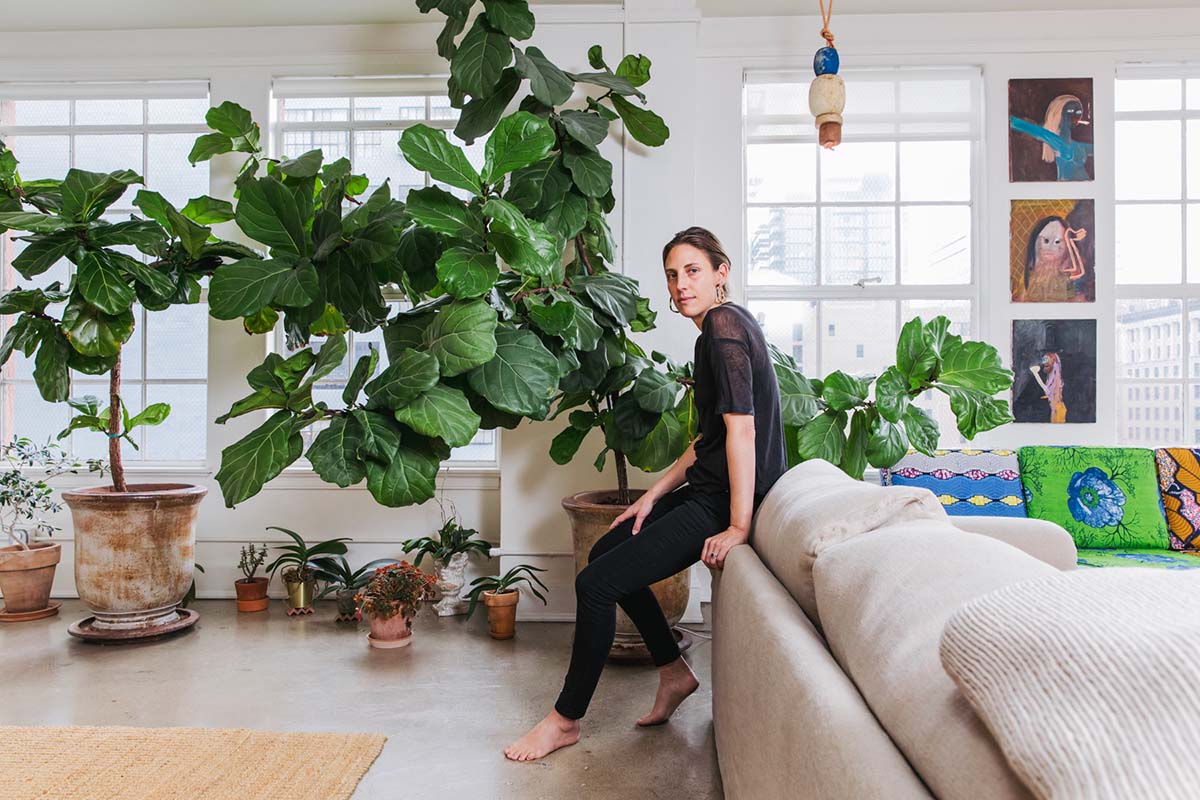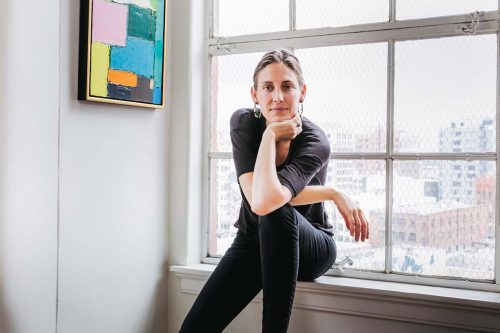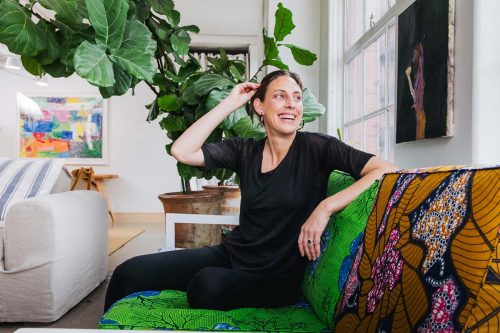
Photo by Christina Gandolfo
From ‘Twin Peaks’ to ‘Us,’ She Sets the Scene
Once a TCU soccer player, Ruth De Jong is a top Hollywood production designer.
With credits ranging from films like Us and Manchester By the Sea to TV shows including Yellowstone and the 2017 reboot of Twin Peaks, Ruth De Jong ’04 has earned a reputation for artistic vision, outsized talent and a formidable work ethic. Her career quickly catapulted her to the top ranks of production designers working in the entertainment industry today.
“Ruth is now one of the most sought-after production designers in Hollywood,” said Jack Fisk, a veteran production designer. “It makes me so happy to see her success.”
De Jong’s career has had its surprises: Working on Yellowstone, a series starring Kevin Costner, directly influenced the purchase of a 60-acre ranch in Livingston, Montana. Her work in the movies put her in the same credit roll as Reese Witherspoon, Lupita Nyong’o and Sean Penn.
Beyond the Ball
De Jong grew up in Charlottesville, Virginia, the oldest of five in a tight-knit clan. She began her college career ensconced on campus in Colby Hall and spending every available minute with her TCU soccer teammates.
“Ruth always worked very hard and was wonderfully poised, with a very creative mind,” said David Rubinson, who founded the TCU women’s soccer program and brought De Jong to the university. “When she gets into something, she goes full bore.”
“One of my other students showed me a picture he’d taken of Ruth as a goalie where she was literally horizontal going for the ball,” said Luther Smith, professor emeritus who taught photography for 35 years at TCU. “That picture made it pretty clear to me who she was. Ruth was somebody who really goes for whatever it is she wants.”
When a fractured thumb sidelined her for much of her first season, De Jong decided to redshirt, resulting in an extra year on campus. She dove headlong into the fine arts with an emphasis on painting and photography.

Ruth De Jong focused on art and painting until a friend’s father, a film production designer, persuaded her to work as his assistant on There Will Be Blood. Photo by Christina Gandolfo
She also worked as a freelance photographer for the Star-Telegram in Fort Worth from 2002 until she graduated, covering everything from rodeos to breaking news. Some days she dreamed of becoming a photojournalist like her father but specializing in war coverage. Other times, she considered joining a professional soccer league in Europe or Asia. All the while, she absorbed the local arts scene, making regular visits to the Kimbell Art Museum, the Modern Art Museum of Fort Worth (built during her time at TCU) and the then-new Nasher Sculpture Center, where she once encountered its founder, Raymond Nasher.
The year she graduated from TCU, New England Financial Group commissioned De Jong to create two large-scale paintings for the Summit Bank Building in Fort Worth.
Galleries across the country and in Italy have exhibited her work in solo and group exhibitions. She would spend months, even years, on each colorful piece, abstract scenes done on paper, wood or canvas.
“Something that Jim [Woodson] instilled in me was patience and consideration and really working and reworking a given piece,” De Jong said.
This abiding interest in visual arts would later inform her approach to film.
“There are always a few students who stand out, and Ruth was one of those,” said Jim Woodson, a painting professor who retired in 2013. “Sometimes you have a student where all you need to do is get out of their way and let them take off. Ruth was one of those. Once she got going, she really got going.”
On Set
Woodson and Smith were delighted when De Jong announced she was planning to attend the Pennsylvania Academy of the Fine Arts for graduate school.
“But my plans got hijacked in a good way,” De Jong said.
Production designer Fisk — the husband of Sissy Spacek and father of actress Schuyler Fisk, one of De Jong’s closest childhood friends — convinced De Jong to work as his assistant on There Will Be Blood, the 2007 film for which Daniel Day-Lewis won the Academy Award for best lead actor.
“Jack told me that production design encompasses all of the arts, but particularly sculpture and painting,” De Jong recalled. “You are creating worlds using basic skills acquired through drawing and painting and the study of light.”
Fisk also assured her that what she didn’t know she could learn on the job. So she deferred graduate school for a year and headed 500 miles south of Fort Worth for the next eight months to prepare for filming.
“I began to refer to Ruth as our ‘secret weapon,’ as she could convince anyone to aid or help us on our journey to get the sets erected in the Texas desert near Marfa,” Fisk said. “Within weeks she was performing as an assistant art director and has never slowed down.”
Being on set was a revelation for De Jong.
“Jack told me not to worry about the protocol of the film world,” she said. “He wanted me to help build these worlds, which turned out was something intuitive to me.”
She deferred grad school again in favor of subsequent film projects, including Terrence Malick’s Tree of Life and Francis Lawrence’s Water for Elephants, moving up to assistant art director on both. She reteamed with Paul Thomas Anderson, director of There Will Be Blood, for 2014’s Inherent Vice, this time as the art director.
Upward Bound
The hierarchy on the production side of a film set begins with the director. Reporting to the director is the production designer, the individual responsible for creating the entire look and feel of a film.
The art director answers to the production designer and manages a crew that typically includes an art department coordinator, a couple of production assistants, a set decorator (akin to an interior designer) and construction teams that include painters, carpenters and sculptors. Even on a modest-sized film, the production designer’s staff can grow to around 200, with teams working at various locations on any given day.

Ruth De Jong’s career has evolved to include an interior design company. Photo by Christina Gandolfo
“It’s like being in an ant colony, with everyone marching around but all knowing what they’re doing,” said De Jong, noting that the prep phase before a shoot can take from two to six months. Filming adds another 30 to 75 days for the kind of midrange-budget movies she typically oversees.
“I love the collaboration, and I love enabling people to do their best work,” she said. She has no problem making changes or replacing people if it’s not working out or a good fit, she added.
De Jong ascended to the top slot as production designer on 2016’s Manchester By the Sea. Casey Affleck took home the Oscar for best actor for his work on the film.
She was expecting her first child throughout the entire shoot on Jordan Peele’s follow-up to his award-winning Get Out. Us was filmed in the late summer and early fall of 2018; De Jong and her husband, location manager Charlie Skinner, welcomed daughter Sadie in February 2019.
The couple met on a shoot for ESPN during summer 2014 but did not start to date until the next year. (That project, a campaign for ESPN on the first ever college football playoffs, brought them to her home turf, TCU, for part of the shoot.) They continue to collaborate professionally; Sadie was crawling when her father wrapped up his third season of Paramount Network’s Yellowstone, on which De Jong worked its entire first season.
The couple own a ranch in Montana, as well as a loft in downtown Los Angeles. They try to dovetail their projects so that only of them will be away from home working at a time.
De Jong’s first post-Us project will be designing Babylon, a film written and directed by Damien Chazelle, who earned acclaim for 2016’s La La Land. Set in 1926, this love letter to old Hollywood, starring Brad Pitt and Emma Stone, will be shot in and around Los Angeles. Shooting begins this summer with an anticipated release date of 2021.
Interior Motives
De Jong and her brother Peter co-founded De Jong & Co., a furniture and home goods line and interior design firm, between movie projects after friends begged her for help in decorating their homes. Peter designs a range of furniture now carried at almost two dozen high-end retailers from Brooklyn to San Francisco.
“We aren’t the type of firm that at any given time has 10 jobs running,” she explained. “Usually we do one at a time and are very specific about how we approach a project.”
Her first commercial property gig was designing hip L.A. eatery Son of a Gun for noted restaurateurs Vinny Dotolo and Jon Shook.
“Ruth knew certain materials would break in and wear nicely,” Dotolo said. “She has great aesthetics and knowledge of sourcing.”
Dotolo was so impressed with her work that he and his wife, jewelry designer Sarah Hendler, hired De Jong to oversee the renovation of their 1928 Tudor-style home in L.A.’s Hancock Park. For the project, Peter created bespoke bookshelves and a coffee table, all sustainably handcrafted in L.A. Though most of her interiors clients are in Southern California, she has also designed the interior of a restaurant in Nashville, Tennessee.
In service of both her film work and design projects, De Jong constantly immerses herself in beauty.
“It’s great to walk through life really looking at everything,” she said. “I am always looking for the next great tile-maker or a new kind of paint. I feel like I go through life with eyes wide open and paying attention to it all.”

Your comments are welcome
Comments
Related reading:
Alumni
David Alan Hall: A Name Behind Hollywood Favorites
The ghostwriter counts Warner Bros., Marvel Studios and Disney franchises among his clients.
Research + Discovery
‘De Niro Method’ Tracks Actor’s Evolving Career
Film scholar R. Colin Tait looks at five decades of artistic accomplishment and how a star can contribute to a director’s vision.
Alumni
Ron Hall’s True Calling
An art dealer’s story of friendship takes on a life of its own as a movie, Same Kind of Different As Me, now in theaters.